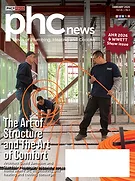The fifth International Emerging Technology Symposium 2016 (IETS) graced the Westin O’Hare in Rosemont, Illinois on May 10-11. During this crucial, in-depth event professionals in the plumbing, mechanical and water efficiency industries spent two days together peeling back research and calling attention to the challenges we continue to face in working with plumbing systems for residential and commercial buildings in the U.S. and abroad.
With the featured topic, “Opportunistic Pathogens in Premise Plumbing,” conversations at IETS were nothing short of stirring. Industry experts and leaders touched on the clashing points of safety and design. The plumbing industry ascribes to the first and foremost “do no harm” in designing and installing systems for buildings. Yet, due to water scarcity and declining quality there has been greater potential for opportunistic pathogens to wreak havoc in premise plumbing and infect building occupants — who, for example, already have jeopardized immune systems or are of lower socioeconomic status — using these systems.
Safe, yet smart engineering was a motif that was highlighted throughout IETS. Experts that led these discussions included: Dr. Marc Edwards, engineering professor and researcher at Virginia Tech; Tim Keane, consulting engineer and principal of Legionella Risk Management, Inc.; and Gary Klein, president of Gary Klein and Associates, Inc. Discussions centered on how engineers can better manage the difficult crossroads they encounter between cost and safety. The experts emphasized smarter — and most often simpler and smaller — plumbing system designs that are cost-effective and carry the least amount of harm for the people who use them.
There were several presentations that took this topic head-on. There was also a panel discussion on proven strategies, needed research on opportunistic pathogens and the potential for the newly published ASHRAE 188P standard on curbing the increasing number of legionellosis outbreaks, particularly in populations that are most vulnerable.
Dr. Marc Edwards, who has been sending shockwaves through the plumbing community and beyond for his water testing efforts in Flint, Michigan, addressed America’s failing infrastructure. Edwards said we need to take responsibility for the growth of opportunistic pathogens, as the number one cause of waterborne diseases in the U.S. In his presentation, he also dived into various engineering control strategies for building owners, focusing especially on water heater set point, in-building disinfection, flow control, heater selection and water age. For utilities, solutions centered on maintaining higher chlorine residuals and upgrading infrastructure.
Andrew Whelton, Ph.D., of Purdue University, also hit on the climbing urgency and the disastrous outcomes that continue to arise because water and public health sectors do not understand premise plumbing. He said that since 2014, more than 100,000 drinking water premise plumbing systems that served more than 1.5 million people have become chemically contaminated. Whelton’s presentation also touched on plumbing decontamination testing results from Purdue University’s pilot-scale facility, field plumbing system decon activities, as well as bench-scale tests involving various materials and decon strategies. What he concluded was that there is a critical need for effective partnerships and applied and fundamental stuadies; without the necessary data we will not be able to safely and rapidly recover plumbing systems.
Janet Stout, director of Special Pathogens Laboratory a.k.a. a “Legionellologist,” has spent over 30 years studying Legionnaires Disease. In her presentation, Stout described the circumstances and conditions that have been linked to outbreaks of the disease. She highlighted the prevention measures of ASHRAE 188, which is the first standard of its kind in the U.S. Approved on June 26, 2015, the standard took 10 years to make it to this point. Its purpose is to establish minimum Legionella risk management requirements for water building systems. In the long run, the implementation of these requirements will save building owners potential liabilities in the future. Though it’s not required, it ultimately leaves owners in a less vulnerable spot.
Bill Gauley, P.E., principal of Gauley Associates Ltd., started a stimulating conversation on the “Hippocratic Oath.” He explored how the water industry can oftentimes be guilty of doing harm because of “over-engineering,” which involves both under and mostly over sizing pipes. He made the point that engineers tend to design systems to meet peak demand that may occur one day once every few years. This is in comparison to the way highway systems are designed, which meet high traffic flows but not peak flows. Gauley urged designers to think as if the money they are allocated is theirs and the outcome will affect them.
Many presentations shared the success stories of plumbing solutions. Dr. Steven Buchberger, of the University of Cincinnati, provided an update on the ASPE/IAPMO/WQA’s peak demand study. The study is breaking new ground on a potential new statistical process for water supply pipe sizing in residential buildings. The report proposes a new probability-based method similar in principle to Hunter’s Curve for determining peak water demands, replacing fixture units with probability of fixture use.
Paula Kehoe, director of the San Francisco Public Utilities Commission, discussed how the city is taking matters into its own many hands with its non-potable water program. When the SFPUC integrated on-site water reuse, resulting in a 65 percent reduction in water reuse, they caused a citywide policy that many commercial and mixed-use buildings adopted. SFPUC sets an example on how to develop public health guidelines that can be adopted by state agencies or local officials to support the adoption of onsite water systems. It is through the collaboration of public health and water utilities, the development of consistent state policies and the engagement of EPA, that Kehoe credits as the continuation of success in reducing water while being accountable for human lives.
Keynote speaker, professor Stuart White, director of the Institute of Sustainable Futures in Sydney, Australia discussed his team’s pathway to create a sustainable future through independent, project-based research. For over 30 years, White has focused on the sustainability needs for a wide range of clientele, including government, industry and community.
An international thread of focus was carried throughout IETS. The symposium welcomed speakers outside the U.S., who are on the same wavelength in terms of challenging the old ways of designing systems.
Dr. Michael Gormley, of the Institute for Building and Urban Design, Heriot-Way University in Scotland, hit on flexible and robust design that meets the unique challenges of today, including changing climate and lifestyle. Gormley illustrated how defective design elements such as fixture drain seals can spread infection and lead to severe consequences.
In his presentation “Uber plumbing technologies from down under,” Jeff Patchell, publisher of Connection Magazines in Australia, discussed the need for a catalyst to create that domino effect leading to innovative plumbing system solutions. Patchell took participants through a timeline of ground-breaking inventions in plumbing system design until today. Patchell was hopeful for the integrative technology of the future; that will connect men in the field to the best practices more directly. He cited “wearable technology” as one such marker of the future in plumbing.
The second day of IETS filled in some of the legislative blanks to bridge some of the long-term research and efforts that concerned experts have been working toward in water quality and scarcity. Mary Ann Dickinson, president and CEO of the Alliance for Water Efficiency, gave an inspiring speech on how policy needs to reflect the urgency of our nation’s water issues, stating that water deserves “a federal champion.”
The EPA portion of the symposium focused on ushering in the next decade of WaterSense. Stephanie Tanner, lead engineer, discussed the impending scarcity problems the U.S. faces. She touched on her team’s refocusing on a systems approach, where more integrative and design-driven systems, not products, dictate water use. It is by balancing water efficiency, health and safety that we will be able to build viable plumbing systems, Tanner reported.
Both days of IETS concluded with panels. The first panel “Water Quality, Water Savings and Water-Energy Nexus — Three Issues, One Solution?” This session was packed with case histories and field studies that called into question the current plumbing systems and design that both save energy and money and reduce risk, and if that’s possible or counter intuitive. They asked the question, can “green” be rebranded to include public health? Keane, Klein and Edwards tackled these issues with precision and research, coming first and foremost from a people-first perspective.
IETS ended with the compelling and important panel, “Mitigating Opportunistic Pathogen Outbreaks from Water in Premise Plumbing Systems.” Dr. Jamie Bartram, of The Water Institute at the University of North Carolina; Dr. Janet Stout; Dr. Andrew Whelton; Keane; Klein; and Edwards addressed the “plumbing crossroads,” embodying the urgency and responsibility we face as plumbing system experts.
The panel talked about the costly, devastating effects of bad plumbing, and on another front the spread of misinformation in the health care industry; that there never has been a greater need to put evidence and best practices all in one place. They discussed strategies as well as successful implementation of ASHRAE 188, which they believe to be a game changer for system design and will hopefully carry over into homes. Researchers urge designers to confront the conservatism that has been built into place and not to be frightened by making changes and continuously evaluating.
IETS was convened by the Alliance for Water Efficiency, American Society of Plumbing Engineers, Canadian Institute of Plumbing & Heating, International Association of Plumbing and Mechanical Officials, Mechanical Contractors Association of America, Plumbing-Heating-Cooling Contractors National Association, Plumbing Manufacturers International, United Association, and World Plumbing Council.
If you missed the conversation this year, don’t miss your chance to hear it when the symposium rolls around next year. Visit www.iapmo.org.





